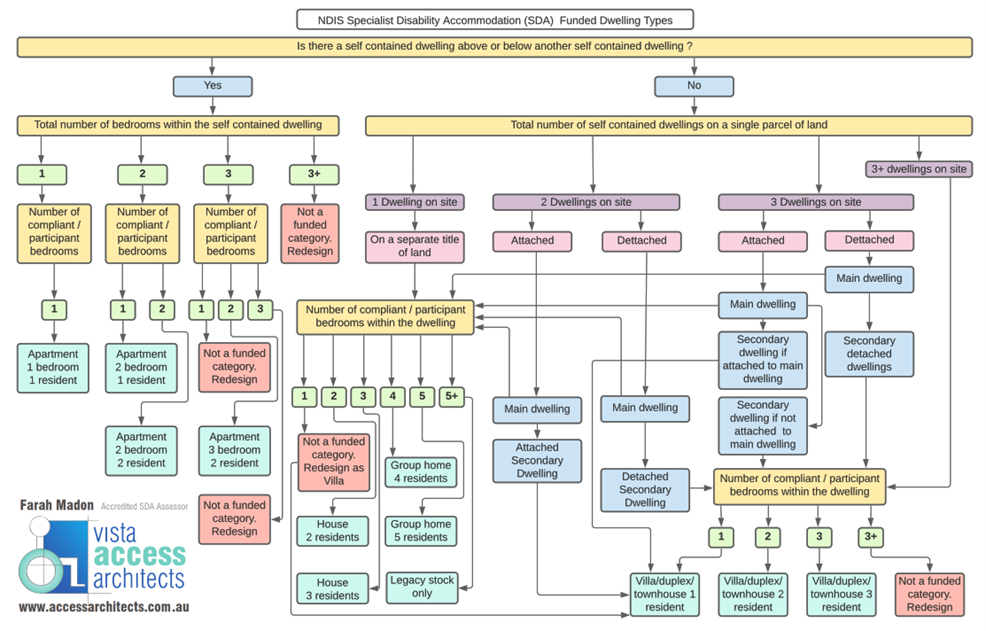 NDIS SDA Dwelling types
NDIS SDA Dwelling types
One of the most common questions we get asked is how to determine the SDA dwelling type. This is not a straightforward answer as what the building industry may refer to as a House or a Group home or a Villa may not neatly fit into the definitions provided for the same under the NDIS Rules 2020.
Funding for an SDA dwelling is based on the Dwelling type and therefore it is therefore essential that the type of the dwelling follows all the requirements as noted in the NDIS Rules 2020.
The definitions of dwelling type used by the NCC may not necessarily match the definition of dwelling type used by the NDIS. For example, what qualifies as a Group home under a NCC or Planning authority can be designed and certified as multiple villas as defined under the Schedule 1 of SDA Rules 2020 as long as all items noted in the SDA Rules 2020 Schedule 1 for type of dwelling are met.
It is the responsibility of the Accredited SDA Assessor to propose the dwelling type and note the same on the SDA Assessment Summary form. The Accredited SDA Assessor shall not rely or be influenced by the SDA developer in determining the dwelling type. Note that NDIA has the right to reject the dwelling type proposed by the SDA Assessor and require change of the dwelling type if the requirements donot comply with the SDA Rules 2020.
If all items noted in the SDA Rules 2020 Schedule 1 for type of dwelling are met then it can be classified as that dwelling type.
SDA Dwelling type |
Funded types |
Requirements |
|
Apartments |
1 bedroom, 1 resident 2 bedrooms, 1 resident 2 bedrooms, 2 residents 3 bedrooms, 2 residents |
Apartments are self-contained units occupying only part of a larger residential building. Apartments are typically built above or below another dwelling. Selfcontained dwellings that are separated from other dwellings by wall alone are not apartments but are likely to be a villa, duplex or townhouse. |
|
Villa/ duplex/ townhouse |
1 resident 2 residents 3 residents |
Villas, duplexes and townhouses are dwellings for one, two or three residents. Villas, duplexes and townhouses are generally separate but semiattached properties within a single land title or strata titled area. Dwellings will be separated by a fire-resisting wall (although fire resistance is not required for Existing Stock). Each villa, duplex or townhouse must have a separate and reasonably accessible entry to/exit from the property, and participants must not be able to internally travel between dwellings. That is, participants must be required to exit one dwelling in order to enter another. Restricted internal access between dwellings may be provided for support staff only. Villas, duplexes and townhouses may also be ancillary dwellings that are located on the same parcel of land as another dwelling (e.g. fully self-contained ‘granny flats’). |
|
Houses |
2 residents 3 residents |
Houses are detached low-rise dwellings with garden or courtyard areas. To be a house (rather than a villa/duplex/townhouse) the dwelling must be located on a clearly separated land area (e.g. separated by a fence, hedge or other form of delineation that is in keeping with the character of the neighbourhood). It must not share a wall, roof, entry area, driveway, car parking or outdoor area with any dwelling other than an ancillary Villa/Townhouse/Duplex with no more than one resident. A house is not to have more than two ancillary Villa/Duplex/Townhouses, otherwise the primary dwelling is likely to be considered a Villa/Townhouse/Duplex. Each house must have a land area that is proportional with the number of residents and keeps with similar properties in the neighbourhood. |
|
Group homes |
4 residents 5 residents |
All requirements for House apply Group Homes are distinguished from other houses by the larger number of residents (four or five long term residents). |
Disclaimer: The flow chart is a free resource developed by Vista Access Architects to simplify the requirements and have been developed based on our interpretation of the requirements. The Flowchart is free to use but at your own risk. By using this Flowchart you agree that you use it at your own risk and Vista Access Architects will take no responsibility for your reliance upon the flowchart. No alterations are permitted to the resouse and author to be attributed when used.
 NDIS SDA Dwelling types
NDIS SDA Dwelling types